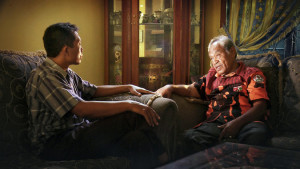 Continuing my wrap-up of films from last year that I didn’t have a chance to review, my selection this week is a documentary that played at the Loft for one night in September as part of its “One Hit Wonder” series. It’s called The Look of Silence, and it’s directed by Joshua Oppenheimer. It’s a kind of sequel to The Act of Killing from a couple years ago which I also reviewed here. Actually, although the two films are linked by their subjects, you don’t have to see the first one to understand or appreciate this one. It has a significance all its own.
Continuing my wrap-up of films from last year that I didn’t have a chance to review, my selection this week is a documentary that played at the Loft for one night in September as part of its “One Hit Wonder” series. It’s called The Look of Silence, and it’s directed by Joshua Oppenheimer. It’s a kind of sequel to The Act of Killing from a couple years ago which I also reviewed here. Actually, although the two films are linked by their subjects, you don’t have to see the first one to understand or appreciate this one. It has a significance all its own.
Now, imagine if the Nazis had not been defeated, but had stayed in power, with the perpetrators of the Holocaust celebrated in Germany as heroes who had protected the country from its enemies. That’s similar to the actual situation in Indonesia. After a military coup in 1965, the new government, with the support of the CIA, instituted a mass slaughter of people that it deemed “communist,” which could be anyone opposing the dictatorship, or anyone part of an ethnic minority such as Chinese, or anyone that it was convenient to kill in order to boost the official body count. Somewhere between one and two million people were murdered by paramilitary groups, along with criminals paid by the government to do its dirty work.
The Act of Killing was about the killers, examining their motives and self-justifications. This latest film, The Look of Silence, focuses on the victims, using the story of one young man named Adi, an ophthalmologist who makes a living traveling around to different villages giving eye exams. A few years before Adi was born, his brother Ramli was taken away by a paramilitary gang and butchered in sickening fashion with a machete, along with others who were murdered near the Snake River in north Sumatra, their bodies thrown into the river by the thousands over a period of months. Oppenheimer interviews two of the killers, who laugh and say that no one would eat the fish from that river after that.
Adi lives with his aged parents in the same home in which he grew up. His father is senile; his mother has never recovered from the murder of her first son, whose spirit she sometimes talks to. With the help of the director, Adi uses his skills as an eye doctor to gain access to various men in his area who participated in the killings. Adi draws them in with casual conversation, then asks a few questions, which gradually become more pointed. When he reveals that his brother was one of the victims, the interviewees get defensive. Some of them get angry. “Stop being so political!” one of them yells. Another accuses Adi of being a communist. Throughout all this, Adi is very calm and serious, never raising his voice. The title The Look of Silence may refer to his quiet gaze. It also evokes the denial that permeates Indonesian society.
Adi’s purpose, and the purpose of the film, is to bring to light a moral accountability that has been repressed and forbidden. The families of the murdered do not seek revenge, for the most part, but acknowledgment that these were crimes against humanity, not heroic acts to be celebrated. And the killers who are confronted know this at some level. Even though society has sanctioned the massacres, the painful truth will always return.
The Look of Silence is a very brave and important film. It’s available on DVD.

